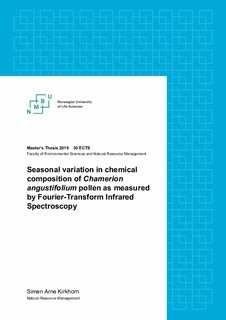| dc.contributor.advisor | Ohlson, Mikael | |
| dc.contributor.advisor | Zimmerman, Boris | |
| dc.contributor.author | Kirkhorn, Simen Arne | |
| dc.date.accessioned | 2019-05-29T09:14:18Z | |
| dc.date.available | 2019-05-29T09:14:18Z | |
| dc.date.issued | 2019 | |
| dc.identifier.uri | http://hdl.handle.net/11250/2599399 | |
| dc.description.abstract | The quality of pollen is of fundamental importance for male reproductive success in spermatophytes, but our knowledge as to whether pollen quality is plastic and varies throughout the flowering season is limited.
Pollen quality can be estimated indirectly through information about the chemical composition of pollen.
In this study, pollen from Chamerion angustifolium was collected from a natural population over the course of a flowering season, lasting 48 days. The chemical composition of pollen was analyzed by Fourier-transform infrared (FTIR) spectroscopy.
Pollen was found to be chemically different throughout the flowering season, revealing a clear correlation between chemical spectra and pollination day. Additionally, pollen size decreased through the flowering season and pollen chemistry differed between two populations.
The indicated plasticity of pollen chemistry throughout the season is important, as it is a major prerequisite for seasonal changes in pollen quality. Whether changed pollen chemistry over the season results in altered pollen quality is still unknown. Additional studies should validate this, by combining FTIR spectroscopy measurements of pollen with measurements of pollen quality parameters. | nb_NO |
| dc.description.abstract | Pollenkvalitet er fundamentalt viktig for befruktningsprosessen hos frøplanter, men kunnskap om hvorvidt pollenets kvalitet er plastisk og endrer seg gjennom blomstringssesongen er begrenset. Pollenkvalitet kan estimeres indirekte ved å kjenne til pollenets kjemiske sammensetning.
I denne studien ble pollen fra geitrams (Chamerion angustifolium) samlet fra en naturlig populasjon, i løpet av en blomstringssesong på 48 dager. Pollenets kjemiske sammensetning ble analysert ved bruk av Fourier-transformert infrarød (FTIR) spektroskopi.
Resultatene viste at pollen er kjemisk forskjellig gjennom blomstringssesongen, og viser en klar korrelasjon mellom pollenets kjemiske spekter og pollineringsdato. I tillegg indikerer resultatene at pollenets størrelse reduseres i løpet av blomstringssesongen, og at pollenets kjemiske sammensetning er forskjellig mellom to populasjoner.
Plastisitet i pollenkjemi gjennom sesongen er viktig, ettersom det er en sentral forutsetning for sesongmessig variasjon i pollenkvalitet. Hvorvidt endret pollenkjemi gjennom sesongen medfører endret pollenkvalitet er fortsatt uvisst. Videre studier bør validere dette ved å kombinere FTIR-spektroskopimålinger av pollen, med målinger av pollenkvalitet-parametere. | nb_NO |
| dc.language.iso | eng | nb_NO |
| dc.publisher | Norwegian University of Life Sciences, Ås | nb_NO |
| dc.rights | Attribution-NonCommercial-NoDerivatives 4.0 Internasjonal | * |
| dc.rights.uri | http://creativecommons.org/licenses/by-nc-nd/4.0/deed.no | * |
| dc.subject | FTIR | nb_NO |
| dc.subject | Chamerion angustifolium | nb_NO |
| dc.subject | Pollen quality | nb_NO |
| dc.subject | Pollen chemical composition | nb_NO |
| dc.subject | Reproductive biology | nb_NO |
| dc.title | Seasonal variation in chemical composition of Chamerion angustifolium pollen as measured by Fourier-Transform Infrared Spectroscopy | nb_NO |
| dc.type | Master thesis | nb_NO |
| dc.subject.nsi | VDP::Mathematics and natural science: 400::Zoology and botany: 480::Ecology: 488 | nb_NO |
| dc.source.pagenumber | 58 | nb_NO |
| dc.description.localcode | M-NF | nb_NO |

